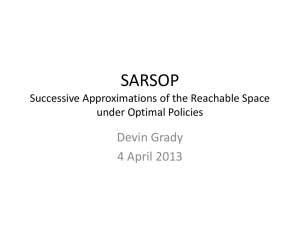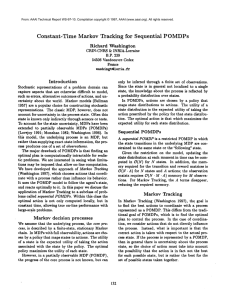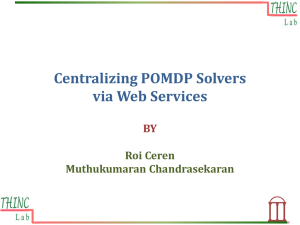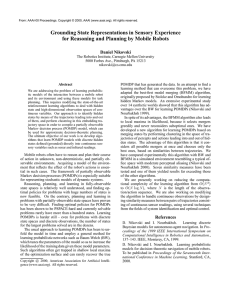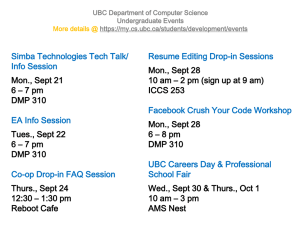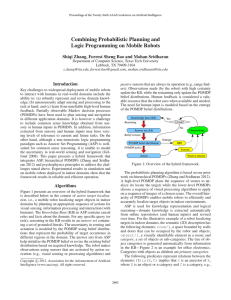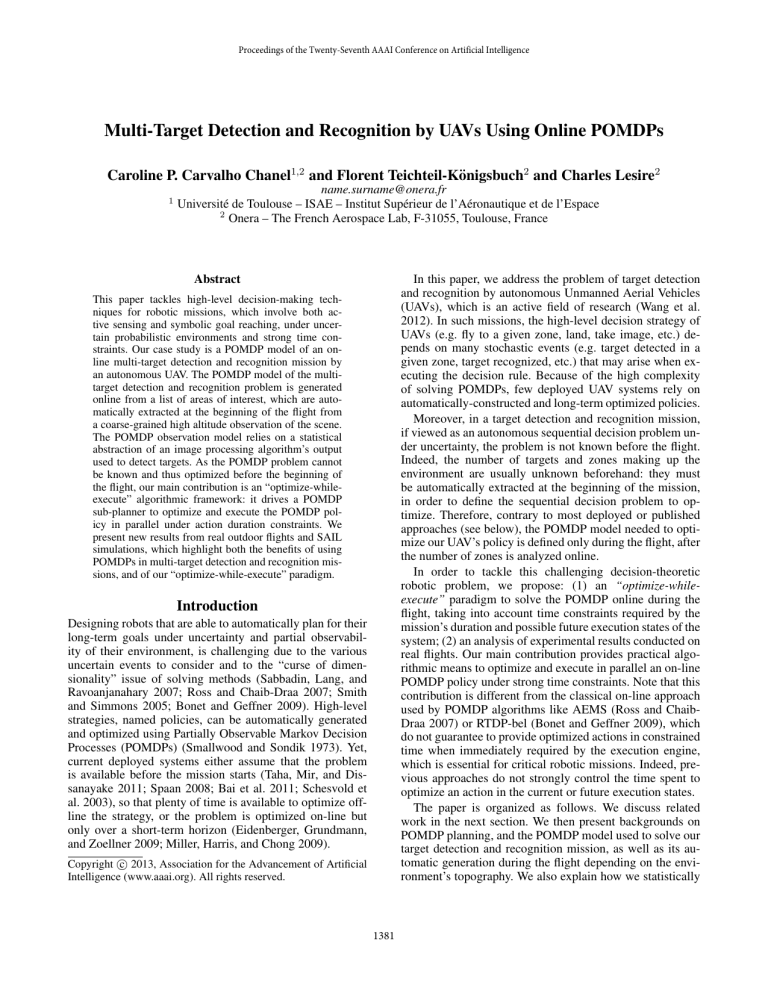
Proceedings of the Twenty-Seventh AAAI Conference on Artificial Intelligence
Multi-Target Detection and Recognition by UAVs Using Online POMDPs
Caroline P. Carvalho Chanel1,2 and Florent Teichteil-Königsbuch2 and Charles Lesire2
1
name.surname@onera.fr
Université de Toulouse – ISAE – Institut Supérieur de l’Aéronautique et de l’Espace
2
Onera – The French Aerospace Lab, F-31055, Toulouse, France
Abstract
In this paper, we address the problem of target detection
and recognition by autonomous Unmanned Aerial Vehicles
(UAVs), which is an active field of research (Wang et al.
2012). In such missions, the high-level decision strategy of
UAVs (e.g. fly to a given zone, land, take image, etc.) depends on many stochastic events (e.g. target detected in a
given zone, target recognized, etc.) that may arise when executing the decision rule. Because of the high complexity
of solving POMDPs, few deployed UAV systems rely on
automatically-constructed and long-term optimized policies.
Moreover, in a target detection and recognition mission,
if viewed as an autonomous sequential decision problem under uncertainty, the problem is not known before the flight.
Indeed, the number of targets and zones making up the
environment are usually unknown beforehand: they must
be automatically extracted at the beginning of the mission,
in order to define the sequential decision problem to optimize. Therefore, contrary to most deployed or published
approaches (see below), the POMDP model needed to optimize our UAV’s policy is defined only during the flight, after
the number of zones is analyzed online.
In order to tackle this challenging decision-theoretic
robotic problem, we propose: (1) an “optimize-whileexecute” paradigm to solve the POMDP online during the
flight, taking into account time constraints required by the
mission’s duration and possible future execution states of the
system; (2) an analysis of experimental results conducted on
real flights. Our main contribution provides practical algorithmic means to optimize and execute in parallel an on-line
POMDP policy under strong time constraints. Note that this
contribution is different from the classical on-line approach
used by POMDP algorithms like AEMS (Ross and ChaibDraa 2007) or RTDP-bel (Bonet and Geffner 2009), which
do not guarantee to provide optimized actions in constrained
time when immediately required by the execution engine,
which is essential for critical robotic missions. Indeed, previous approaches do not strongly control the time spent to
optimize an action in the current or future execution states.
The paper is organized as follows. We discuss related
work in the next section. We then present backgrounds on
POMDP planning, and the POMDP model used to solve our
target detection and recognition mission, as well as its automatic generation during the flight depending on the environment’s topography. We also explain how we statistically
This paper tackles high-level decision-making techniques for robotic missions, which involve both active sensing and symbolic goal reaching, under uncertain probabilistic environments and strong time constraints. Our case study is a POMDP model of an online multi-target detection and recognition mission by
an autonomous UAV. The POMDP model of the multitarget detection and recognition problem is generated
online from a list of areas of interest, which are automatically extracted at the beginning of the flight from
a coarse-grained high altitude observation of the scene.
The POMDP observation model relies on a statistical
abstraction of an image processing algorithm’s output
used to detect targets. As the POMDP problem cannot
be known and thus optimized before the beginning of
the flight, our main contribution is an “optimize-whileexecute” algorithmic framework: it drives a POMDP
sub-planner to optimize and execute the POMDP policy in parallel under action duration constraints. We
present new results from real outdoor flights and SAIL
simulations, which highlight both the benefits of using
POMDPs in multi-target detection and recognition missions, and of our “optimize-while-execute” paradigm.
Introduction
Designing robots that are able to automatically plan for their
long-term goals under uncertainty and partial observability of their environment, is challenging due to the various
uncertain events to consider and to the “curse of dimensionality” issue of solving methods (Sabbadin, Lang, and
Ravoanjanahary 2007; Ross and Chaib-Draa 2007; Smith
and Simmons 2005; Bonet and Geffner 2009). High-level
strategies, named policies, can be automatically generated
and optimized using Partially Observable Markov Decision
Processes (POMDPs) (Smallwood and Sondik 1973). Yet,
current deployed systems either assume that the problem
is available before the mission starts (Taha, Mir, and Dissanayake 2011; Spaan 2008; Bai et al. 2011; Schesvold et
al. 2003), so that plenty of time is available to optimize offline the strategy, or the problem is optimized on-line but
only over a short-term horizon (Eidenberger, Grundmann,
and Zoellner 2009; Miller, Harris, and Chong 2009).
Copyright c 2013, Association for the Advancement of Artificial
Intelligence (www.aaai.org). All rights reserved.
1381
using Bayes’ rule (Smallwood and Sondik 1973).
Solving POMDPs consists in constructing a policy π :
∆ → A, which maximizes some criterion generally based
on accumulated rewards averaged over belief states. When
symbolic rewarded goals must be achieved, like landing near
a specific target, a criterion based on long-term average discounted accumulated rewards from
P∞ any initial belief state
is reasonable: V π (b) = Eπ [ t=0 γ t r(bt , π(bt ))|b0 = b]
where γ is the discount factor.
The optimal value of belief states is proven to be piecewise linear and convex, and solution of Bellman’s equation
(Smallwood and Sondik 1973): i.e, at step n < ∞, the value
function can be represented by a set of hyperplanes over ∆,
known as α-vectors. Actions are associated with α-vectors,
and they are optimal over a region of the belief state space
where their corresponding α-vectors dominate others.
Recent offline solving algorithms, e.g. PBVI (Pineau,
Gordon, and Thrun 2003), HSVI2 (Smith and Simmons
2005) and SARSOP (Kurniawati, Hsu, and Lee 2008), and
online algorithms like RTDP-bel (Bonet and Geffner 2009)
and AEMS (Ross and Chaib-Draa 2007), approximate the
value function with a bounded set of belief states B, where
B ⊂ ∆. These algorithms implement different heuristics to
explore the belief state space using probabilistic trials, and
update the value of V , which is represented by a set of αvectors (except in RTDP-bel and AEMS), updating only the
explored or relevant belief states b ∈ B. Therefore, V is
reduced and contains a limited number |B| of α-vectors.
Note that most – if not all – algorithms do not provide
any means to control the time spent to update the value of
a given belief state. They do not permit to stop at a precise
time a belief set value update, or a trial in the belief space
once launched. Thus, the execution engine must wait for the
current value update over the set of beliefs to end, before applying the next action. For time-constrained robotic applications, time is so critical that we cannot assume that the time
spent by the POMDP solver to optimize the next action is not
strictly controllable. In this paper, we present a technique to
leverage this cumbersome limitation of existing approaches.
build a probabilistic abstraction of the image processing algorithm’s classifier output, which feeds our POMDP observation model. Then, we detail our “optimize-while-execute”
algorithmic paradigm required to optimize and execute in
parallel online POMDP policies. Finally, we discuss simulated and real-flight experiments.
Related work
POMDPs have been successfully implemented in many real
robotic missions, e.g.: intelligent camera network for target tracking (Spaan 2008), ground robotics (Candido and
Hutchinson 2011; Eidenberger, Grundmann, and Zoellner
2009), goal detection and active sensing in aerial robotic
missions (Miller, Harris, and Chong 2009; Schesvold et
al. 2003; Bai et al. 2011), and assistance to disabled persons (Taha, Mir, and Dissanayake 2011). From a practical viewpoint, these approaches can be globally classified
in two groups. In the first group, the problem to solve is
known in advance, so that the mission can be solved offline.
Spaan (2008) uses a POMDP model to control a camera network in order to track targets. Bai et al. (2011) model an
aircraft collision avoidance mission as a POMDP to automatically generate the threat resolution logic of the collision avoidance system. Offline POMDP methods have also
been recently proposed to model the interaction between
robotic devices and human operators (Taha, Mir, and Dissanayake 2011). In the second group, the POMDP problem
is optimized online, but over a very short-term horizon –
only the next action to perform in most approaches. Eidenberger, Grundmann, and Zoellner (2009) propose a POMDP
model of active sensing with an optimization criterion based
on information-theory. Miller, Harris, and Chong (2009) use
a continuous POMDP framework for UAV’s guidance in order to perform multi-target tracking. Finally, Candido and
Hutchinson (2011) also tackle continuous POMDPs to address the problem of motion planning under collision avoidance constraints.
In this paper, due to the nature of our multi-target detection and identification mission in an uncertain environment,
we need for a radically different approach. Namely, we have
to optimize a complex POMDP problem known only at running time, which has to be solved over a long-term horizon
in order to maximize information gathering and the chance
of achieving a symbolic mission goal: landing near a specific target that has to be detected and distinguished from
other targets in the scene.
POMDP model of the target detection and
recognition mission
Mission description
We consider an autonomous Unmanned Aerial Vehicle
(UAV) that must detect and recognize some targets under
real-world constraints. The mission consists of detecting and
identifying a car that has a particular model among several
cars scattered in an unknown environment, and of landing
close to this car. Due to the partial observability of objects
in the scene, we model our mission as a POMDP with probabilistic beliefs about cars’ models. The UAV can perform
both high-level mission tasks and perception actions. We do
not assume any prior number of cars in the scene, which can
be in any of many zones in the environment (but no more
than one car per zone). Zones are extracted online by image
processing, before optimizing the POMDP policy.
The total number of states depends on variables that are
all discretized: the number of zones (Nz ), height levels (Nh ),
Formal framework: POMDP
A POMDP is a tuple hS, A, Ω, T, O, R, b0 i where S is a set
of states, A is a set of actions, Ω is a set of observations,
T : S × A × S → [0; 1] is a transition function such that
T (st+1 , a, st ) = p(st+1 | a, st ), O : Ω × S → [0; 1] is
an observation function such that O(ot , st ) = p(ot |st ), R :
S × A → R is a reward function associated with a stateaction pair, and b0 is the initial probability distribution over
states. We note ∆ the set of probability distributions over
the states, called belief state space. At each time step t, the
agent updates its belief state defined as an element bt ∈ ∆
1382
and car models (Nmodels ), as well as a terminal state that
characterizes the end of the mission. As cars (candidate targets) can be in any of the zones and be of any possible model
a priori, and there is possibly no car in a given zone, thus the
total number of states is: |S| = Nz · Nh · (Nmodels + 1)Nz +
Ts , where Ts represents the terminal state.
For this application case, we consider 5 possible observations (|Ω| = 5) in each state: {no car detected, car detected
but not identified, identified as model A, identified as model
B, identified as model C}. These observations rely on the result of image processing (described later) and on the number
of car models in the database.
High-level tasks performed by the autonomous UAV are:
moving between zones, changing height level, changing
view angle, landing. Actions for moving between zones
(resp. height levels) are: go to(ẑ) (resp. go to(ĥ)), where ẑ
(resp. ĥ) represents the zone (resp. height level) to go to. The
change view action changes the view angle when observing
a given zone. The land action can be performed by the autonomous UAV at any moment and in any zone. Moreover,
the land action finishes the mission. So, the total number of
actions is: |A| = Nz + Nh + 2.
the distance between zones (resp. difference between height
levels) and the cost modeling the time spent by the image
processing algorithm. Zone coordinates are only known at
the beginning of the flight after a first exploration of the
environment, so that the POMDP problem is automatically
compiled during the flight given the extracted zones.
action change view: this is a high-level action that changes
the view angle of the UAV when observing cars. Note that
we do not assume any prior orientation of cars. This action
does not change the POMDP state, which only relies on the
UAV’s current zone and height level. The execution engine
is in charge of making the UAV turn around the zone of about
10 degrees (w.r.t the zone’s center), in order to observe the
target from a different view angle. This abstraction allows us
to significantly reduce the number of state variables (hence
POMDP states), while remaining realistic enough. The cost
associated with the change view action is proportional to
the distance between the UAV position and the new position,
and also to the computation time of the image processing
engine, which is ran in each new view angle.
action land: this action completes the mission, leading the
autonomous UAV to the terminal state. It brings a reward
when the UAV lands in the zone where the searched target is
actually located. Note that the model of the searched target
(SeT a ), i.e. one of {modelA , modelB , modelC }, is only
known at the beginning of the mission during the flight.
Finally, if the UAV is in the terminal state (Ts ), all these
actions have no effects and no cost.
Model dynamics
State variables. The world state is described by discrete state variables. We assume that we have some basic prior knowledge about the environment: there are at
most Nz zones, which contain each at most one target. The set of target models is finite, i.e. Nmodels =
{modelA , modelB , modelC }. State variables are: z with
Nz possible values, that indicates the UAV’s position; h with
Nh possible values, that indicates its height levels; IdT az1
(resp. IdT az2 , IdT az3 , etc) with Nmodels + 1 possible values, that indicates the identity (car model) of target in z1
(resp. target in z2 , etc.).
Observation model. POMDP models require a proper
probabilistic description of actions’ effects and observations, which is difficult to obtain in practice for real complex applications. For our target detection and recognition
mission, we automatically learned from real data the observation model, whose symbols are produced by an image processing algorithm. We recall that we consider 5 possible observations in each state: {no car detected, car detected but
not identified, car identified as model A, car identified as
model B, car identified as model C}. The key issue is to assign a prior probability on the possible semantic outputs of
image processing given a particular scene.
Car observation is based on an object recognition algorithm (Saux and Sanfourche 2011), which is already embedded on-board our autonomous UAV. It takes as input one
shot image (see Fig. 1(b)) that comes from the UAV onboard camera. First, the image is filtered to automatically detect if the target is in the image. If no target is detected, it directly returns the label no car detected. Otherwise, it extracts
the region of interest of the image (bounding rectangle on the
third picture in Fig. 1(b)), then generates a local projection
and compares it with 3D template silhouettes recorded in a
database of car models. The local projection only depends
on the UAV’s height level, camera focal length and azimuth
as viewing-condition parameters. The current height level is
updated at every time step, whereas the focal length and the
camera azimuth are fixed parameters. Finally, the image processing algorithm chooses the 3D template that maximizes
the similarity in the database, and returns the label that corresponds or not to the searched target: modelA , modelB or
Transition and reward functions. Based on previous
missions with our UAV, we know that moving and landing actions are sufficiently precise to be considered as deterministic: the effect of going to another zone, or changing
flight altitude, or landing, is always deterministic. However,
the problem is still a POMDP, because observations of cars’
models are probabilistic. Moreover, it has been proved that
the complexity of solving POMDPs essentially comes from
probabilistic observations rather than from probabilistic action effects (Sabbadin, Lang, and Ravoanjanahary 2007).
In order to be compliant with the POMDP model, which
assumes that observations are available after each action is
executed, all actions of our model provide an observation of
cars’ models. The only possible observation after the landing
action is no car detected. All other actions described bellow
automatically take images of the scene available in front of
the UAV, giving rise to image processing and classification
of observation symbols (see later). As the camera is fixed, it
is important to control the orientation of the UAV in order to
observe different portions of the environment.
action go to(ẑ) (go to(ĥ)): this action brings the UAV to
the desired zone (resp. height level). The cost associated
with this action models the fuel consumption depending on
1383
o1
o2
o5
o3
s
o4
Filtering
Detection
ROI
Matching
obs. (oi )
no car
not ident.
as A
as B
as C
p̂(oi |s)
0.0061
0.1177
0,6809
0,0601
0,1351
σp̂
0.0023
0,0095
0,0137
0,0070
0,0101
I = [p̂ ± 3σp̂ ]
[0 ; 0.0129]
[0,0891 ; 0,1462]
[0,6396 ; 0,7221]
[0,0391 ; 0,0812]
[0,1048 ; 0,1654]
(a) More than 500 images per state. (b) Target detection and recognition image pro- (c) Exemple of probability table for a given
cessing (Saux and Sanfourche 2011).
state s; σp represents the standard error.
Figure 1: Identification of the observation model p̂(o|s), where s = {z, h, IdT az = modelA }.
Parallel optimization and execution
modelC . If the level of similarity is less than a hand-tuned
threshold, the image processing algorithm returns the label
car detected but not identified.
Complex UAV missions defined as large POMDPs can
rarely be optimized online, because of the lack of sufficient computational means. Moreover, the problem to solve
is not always known in advance, e.g. our target detection and
recognition mission, where the POMDP problem is based on
zones that are automatically extracted from online images
of the environment. Such applications require an efficient
online framework for solving large POMDPs under strong
time constraints, and executing policies before the mission’s
deadline. We worked on extending the ”optimize-whileexecute” framework proposed in (Teichteil-Konigsbuch,
Lesire, and Infantes 2011), restricted to deterministic or
MDP planning, to POMDPs. Concretely, we generalized this
algorithmic framework, which was based on completely observable states, to belief states and point-based paradigms
used by state-of-the-art POMDP planners.
The extension is not an easy task. In (TeichteilKonigsbuch, Lesire, and Infantes 2011), the execution engine and the planner have full access to the system’s states.
In a POMDP context, the execution engine and the planner
can only access observations, so that they have to maintain
a belief state (probability distribution over states). The idea
is to drive a standard POMDP planner which is called from
possible future beliefs states while executing the current optimized action in the current belief state, in anticipation of
the probabilistic evolution of the system-environment pair.
The optimize-while-execute paradigm is depicted in
Alg. 1. It is an anytime meta planner, composed of an execution component and a planning component. The latter drives
any POMDP planner like PBVI, HSVI, AEMS, RTDP-bel.
It is strictly anytime in the sense of policy execution under
time constraints: the planning component ensures to return
an applicable action in any possible belief state at a precise
time point, when required by the execution component.
First, let us define a planning request: it consists of a request sent by the execution engine to the meta planner, containing: a future possible belief state from which the planner
must compute an optimized action, the time allocated to improve the policy from this belief state, the algorithm used to
improve the policy, and its parameters. Second, an action request is used by the execution engine to get the action whose
optimization was launched at some time in the past for the
current belief state. If no action is available, a heuristic default action is returned. Each component works on an independent thread: the execution engine, which manages policy
execution, runs in the execution thread that interacts with the
system’s engine; it competes with the meta planner, which is
In order to learn the POMDP observation model from
real data, we performed many outdoor test campaigns with
our UAV and some known cars. It led to an observation
model learned via a statistical analysis of the image processing algorithm’s answers, using images taken during these
tests. More precisely, to approximate the observation function O(ot , st ), we count the number of times that one of
the 5 observations was an answer of the image processing
algorithm in a given state s (see Fig. 1(a)). So, we compute the following estimation p̂(oi |s), where oi is one of the
PNexp
1
5 possible observations: p̂(oi |s) = Nexp
n=1 I{on =oi |s} .
Nexp represents the number of experiences, i.e. the number
of runs of the image processing algorithm for the different
images, and on the label obtained at experience n. It applies
the usual estimator of the mean of a Bernoulli distribution,
which estimates the probability of oi against the other observations. It is proven to converge in probability to p(oi |s)
as Nexp → ∞. More than 500 images are analyzed for each
state (Nexp 1), so that the statistical approximations may
be good enough. We also computed intervals in which the
true model lies with 99% confidence.
Moreover, this learning method can be performed off-line
because it is independent from the zones that will be extracted during the mission. The estimation p̂(oi |s) is computed for each possible target and height level, but independently from the zone used to learn it. Finally, this parametric model allows us to automatically generate the POMDP
model at the beginning of the mission, after an initial flight
phase where zones of interest are detected by a specific
image processing algorithm not described in this paper.
Thereby, once zones are discovered, the POMDP model’s
rewards can be generated on the basis of zone coordinates.
Fig. 1(c)’s table shows an example of learned observation probabilities. We precomputed such tables for all possible state variable instantiations on which the observations
depend. Note that no learning phase to further improve the
observation model is performed during the actual mission
flight. We dismissed the use of reinforcement learning techniques because: (1) we need to learn only the observation
model, but not the actions’ effects nor the reward function;
and (2) our UAV is too expensive to take the risk to destroy
it while learning the best strategy.
1384
3.0e+01
2.0e+01
4.0e+01
3.0e+01
2.0e+01
3.0e+01
2.0e+01
1.0e+01
1.0e+01
0.0e+00
0.0e+00
0.0e+00
50
100
150
time (s)
200
0
50
100
150
time (s)
200
optimization thread
execution thread
Bellman error
5.0e+01
4.0e+01
1.0e+01
0
6.0e+01
optimization thread
execution thread
Bellman error
5.0e+01
Bellman error
4.0e+01
6.0e+01
optimization thread
execution thread
Bellman error
5.0e+01
Bellman error
Bellman error
6.0e+01
optimization thread
execution thread
Bellman error
5.0e+01
Bellman error
6.0e+01
4.0e+01
3.0e+01
2.0e+01
1.0e+01
0.0e+00
0
50
100
150
time (s)
200
0
50
100
150
time (s)
200
(a) Timelines for classical use (b) Timelines for classical use (c) Timelines for classical use (d) Timelines for AEMS imof AEMS (interleaved approach) of AEMS (interleaved approach) of AEMS (interleaved approach) plementation in our ”optimizewith 4s for planning.
with 3s for planning.
with 2s for planning.
while-execute” framework.
Figure 2: Interleaving optimization and execution versus optimize-while-execute paradigm.
Algorithm 1: optimize-while-execute
1
2
3
4
5
6
7
8
9
10
11
12
often the belief states of the queued optimization requests
during their allocated times, thus providing better optimized
actions than using other underlying POMDP planners. Note
that AEMS actually relies on a global allocated planning
time, but we still cannot control the time spent in each trial,
thus the need for our framework.
b ← initial belief state;
Send planning request(b, bootstrap time, algorithm) ;
Wait for bootstrap’s end;
while stop meta planner requested = false do
a ← action request(b);
Execute action a;
∆a ← expected duration of action a;
O ← get effects of action a (possible observations);
for 0 < i < |O| do
b0 ← compute next belief from Bayes’ rule ;
∆0 ∼ ∆a ∗ p(o|a, b);
Send planning request(b0 , ∆0 , algorithm);
Why optimizing-while-executing?
Figure 2 highlights the benefits of our approach compared
with the classical approach of AEMS for different planning
times (4, 3 and 2 seconds), which consists in interleaving
planning and execution, i.e. it plans for the current belief
state (for a long-term horizon) at every decision epoch, but
not in advance for the future ones as in our optimize-whileexecute approach. The x axis represents the time elapsed
during the mission. Red (resp. blue) bars represent the portions of time where the policy is optimized in the optimization thread (resp. executed in the execution thread) –
both running in parallel when solving our target detection
and recognition POMDP. The curve shows the evolution of
Bellman’s error during the mission, which emphasizes the
evolution of the optimization process. To highlight our approach, we fixed the mission’s maximum allowed duration
to 180 seconds. With the classical use of AEMS (Fig. 2(a),
2(b) and 2(c)), we can easily notice that the mission’s total time increases with the time allocated to plan from the
current execution state. Successive red bars show that the
POMDP needs to be (re-)optimized in each new execution
state. On the contrary, our approach (Fig. 2(d)) permanently
optimizes for future possible execution states while executing the action in the current execution state, so that optimized actions are always immediately available in each new
execution state. As the result, the mission’s duration is lower
with our approach than with the interleaved approach (at
least 30% less).In other words, in our approach the amount
of time saved relies on the sum of time slices of the classical approach when the optimization thread is idle. The more
actions get time to be executed, the more time will be saved.
In Fig. 3, we still compare our optimize-while-execute approach using AEMS, named AEMSowe in the plots, with the
traditional interleaved use of AEMS for different planning
times. This comparison is made on two study cases with 3
zones (Nz = 3). In case 1, the searched target is located in
zone 2, while in case 2 it is in zone 3. The UAV starts in
zone 1. For each environmental setting and each algorithmic
version of AEMS, we ran 50 software-architecture-in-theloop (SAIL) simulations of the mission using images taken
Wait until action a has completed;
o ← get observation;
Remove all planning requests;
b ← update current belief state with a and o;
13
14
15
16
in charge of policy optimization in a concurrent thread.
Initially, the execution engine sends a planning request to
the meta planner for the initial belief state (bootstrap, line 2).
After a certain amount of time (line 3), the execution engine
sends an action request in order to get the optimized action
for this belief (line 5). Then, while executing the action optimized in the current belief state, it will anticipate the environment’s evolution by planning in advance for the next
possible belief states.
To compute next belief states, we ask the anytime planner
what are the probabilistic effects of the action that is being
run in the current belief state. We consider observations as
effects, so we construct the next belief states for each possible observation (lines 8-10). And so, we compute the policy
for each of them during a time proportional to the action’s
predicted duration and to the probability of each possible
observation1 (line 11).
We implemented this meta planner using the state-ofthe-art algorithm AEMS as the underlying POMDP planner. AEMS is particularly useful for our optimize-whileexecute framework, since it is more reactive than other
online POMDP planners. Each iteration of AEMS’ main
loop is usually faster than other solving methods (Ross and
Chaib-Draa 2007), which increases the chance that an action has been optimized in the belief state of an incoming
action request. It also allows our framework to update more
1
We actually defined several time allocation strategies, like giving priority to belief states whose estimated value is more uncertain, but we have not evaluated and compared them for the moment.
1385
success
average and std. dev. mission total time
average and std. dev. planning time
time out
def. actions
success
average and std. dev. mission total time
100
average and std. dev. planning time
time out
def. actions
100
140
100
80
80
120
80
100
time (s)
time (s)
60
60
40
40
40
60
40
20
20
60
80
20
20
0
0
AEMS2s AEMS3s AEMS4s AEMSowe
0
0
AEMS2s
AEMS3s
AEMS4s
AEMSowe
AEMS2s AEMS3s AEMS4s AEMSowe
AEMS2s
AEMS3s
AEMS4s
AEMSowe
(a) Avg. time for successful mis- (b) Percentages among missions (c) Avg. time for successful mis- (d) Percentages among missions
sions for the study case 1.
for the study case 1.
sions for the study case 2.
for the study case 2.
Figure 3: Results for software-in-the-loop simulations.
t=0
a = go to(h2 )
t=1
a = change view
t=2
a = goto zone(z2 )
t=3
a = change view
t=4
a = change view
t=5
a = go to(z3 )
t=6
a = change view
t=7
a = land
o = not ident.
o = no car
o = as A
o = as A
o = as A
o = as C
o = as C
o = no car
Figure 4: Sequence of decisions for time step t. Each image represents the input of the image processing algorithm after the
current action a is executed. Observations o represent the successive outputs of the image processing algorithm’s classifier.
during real flights. Our SAIL simulations use the exact functional architecture and algorithms used on-board our UAV,
a Yamaha Rmax adapted to autonomous flights, as well as
real outdoor images. We averaged the results and analyzed
the total mission time and planning time, the percentage of
timeouts and successes in terms of landing near the searched
a
a
car. Action durations are uniformally drawn in [Tmin
, Tmax
],
a
a
with Tmin = 8s and Tmax = 10s, which is representative
of durations observed during real test flights. As expected,
AEMSowe permanently optimizes the policy in background,
contrary to the interleaved approach. As a result, it is more
reactive: it has the minimum mission’s time (Fig. 3(a) and
3(c)), while providing the best percentage of successes and
the minimum number of timeouts (Fig. 3(b) and 3(d)). Note
that, in Fig 3(a), AEMS2s performs better in averaged mission time (avg. over successful missions), but the percentage of successful missions is lower than in our approach
((Fig. 3(b)). Furthermore, less than 20% of default actions
were used, which shows the relevance of optimizing actions
in advance for the future possible belief states.
Figure 4 presents the sequence of actions performed by
the autonomous UAV per time step during one of the real
flights. Initially, the UAV is in zone 1 at an altitude of 30
meters. After the 2 first steps, the UAV observes that there
is no car in this zone, thus it chooses to change to zone 2.
After 3 steps, it concludes that the target observed in zone 2
is of type A. So, it decides to change to zone 3, and after 2
more observations, the UAV believes that the target C is in
zone 3 (which is correct) and chooses to land. In this way it
correctly terminates the mission.
Real flight experiments
Conclusion and future work
In this section, we present results obtained during real flight
experiments, where the optimize-while-execute framework
was embedded on-board the UAV. We considered 2 height
levels (30 and 40 meters), at most 3 targets of 3 possible
car models, and 3 zones are extracted at the beginning of
the mission. The aim is to land next to the car model C;
however, the number of cars actually present in the scene and
the models of these cars are unknown at the beginning of the
mission. These real flights involve few states, but note that
the need for POMDPs in this kind of applications is more
related to the expressiveness and accuracy of probabilistic
observation functions, than to the size of the problem.
The trajectory performed by the UAV is shown in Fig. 5.
The coordinates are expressed in the local reference system
of the experimental flight terrain. The black cross, orange
cross and blue star, respectively represent zone 1, 2 and 3
(where the searched target is located).
To the best of our knowledge, this paper presents one of
the first POMDP real flight implementations of multi-target
detection and recognition mission by an autonomous UAV
using AI modern planning techniques. The POMDP model
is automatically compiled during the flight and relies on
a meaningful probabilistic observation model learned from
the outputs of an image processing algorithm. The POMDP
optimized policy deals both with sensing actions (determining the best view angle for each target), and with symbolic goals (landing near the searched target). We also provide practical algorithmic means to optimize and execute
POMDP policies in parallel under time constraints, which
is required because the POMDP problem is unknown before
the flight and the mission’s duration is especially short.
Our experiments, particularly real flights, demonstrate
that POMDP planning techniques are now mature enough
to tackle complex aerial robotic missions, assuming the use
50
40
z
30
20
10
0
5
10 15
20 25
30 35
0
40 45
50 55 -20
x
160
140
120
100
80
60
y
40
20
Figure 5: UAV’s trajectory performed during the real flight.
1386
Spaan, M. 2008. Cooperative Active Perception using
POMDPs. Association for the Advancement of Artificial Intelligence - AAAI.
Taha, T.; Mir, J. V.; and Dissanayake, G. 2011. A pomdp
framework for modelling human interaction with assistive
robots. In Int. Conf. on Robotics and Automation (ICRA’11).
Teichteil-Konigsbuch, F.; Lesire, C.; and Infantes, G. 2011.
A generic framework for anytime execution-driven planning in robotics. In Int. Conf. on Robotics and Automation
(ICRA’11).
Wang, J.; Zhang, Y.; Lu, J.; and Xu, W. 2012. A Framework
for Moving Target Detection, Recognition and Tracking in
UAV Videos. In Advances in Intelligent and Soft Computing,
volume 137. Springer Berlin / Heidelberg. 69–76.
of realistic observation models and some kind of “optimizewhile-execute” framework, as proposed in this paper. Possible future research improvements include: taking into account safety constraints imposed by civil aeronautical agencies when optimizing the strategy; and building POMDP
policies that deal with the standard deviations or the confidence intervals of the learned observation model.
References
Bai, H.; Hsu, D.; Kochenderfer, M.; and Lee, W. S. 2011.
Unmanned Aircraft Collision Avoidance using ContinuousState POMDPs. In Robotics Science and Systems (RSS’11).
Bonet, B., and Geffner, H. 2009. Solving POMDPs: RTDPbel vs. point-based algorithms. In Int. Joint Conf. on Artificial Intelligence (IJCAI’09).
Candido, S., and Hutchinson, S. 2011. Minimum uncertainty robot navigation using information-guided POMDP
planning.
In Int. Conf. on Robotics and Automation
(ICRA’11).
Eidenberger, R.; Grundmann, T.; and Zoellner, R. 2009.
Probabilistic action planning for active scene modeling in
continuous high-dimensional domains. In Int. Conf. on
Robotics and Automation (ICRA’09). IEEE.
Kurniawati, H.; Hsu, D.; and Lee, W. 2008. SARSOP: Efficient point-based POMDP planning by approximating optimally reachable belief spaces. In Robotics Science and Systems (RSS’08).
Miller, S. A.; Harris, Z. A.; and Chong, E. K. P. 2009.
A POMDP framework for coordinated guidance of autonomous UAVs for multitarget tracking. EURASIP J. Adv.
Signal Process 2:1–2:17.
Pineau, J.; Gordon, G.; and Thrun, S. 2003. Point-based
value iteration: An anytime algorithm for POMDPs. In Int.
Joint Conf. on Artificial Intelligence (IJCAI’03).
Ross, S., and Chaib-Draa, B. 2007. AEMS: An anytime online search algorithm for approximate policy refinement in
large POMDPs. In Int. Joint Conf. on Artificial Intelligence
(IJCAI’07).
Sabbadin, R.; Lang, J.; and Ravoanjanahary, N. 2007. Purely
epistemic Markov Decision Processes. In AAAI-07.
Saux, B., and Sanfourche, M. 2011. Robust vehicle categorization from aerial images by 3D-template matching and
multiple classifier system. In Int. Symposium on Image and
Signal Processing and Analysis (ISPA).
Schesvold, D.; Tang, J.; Ahmed, B.; Altenburg, K.; and Nygard, K. 2003. POMDP planning for high level UAV decisions: Search vs. strike. In Int. Conf. on Computer Applications in Industry and Enineering.
Smallwood, R., and Sondik, E. 1973. The optimal control of
partially observable Markov processes over a finite horizon.
Operations Research 1071–1088.
Smith, T., and Simmons, R. 2005. Point-based POMDP
algorithms: Improved analysis and implementation. In Conf.
on Uncertainty in Artificial Intelligence (UAI’05).
1387

